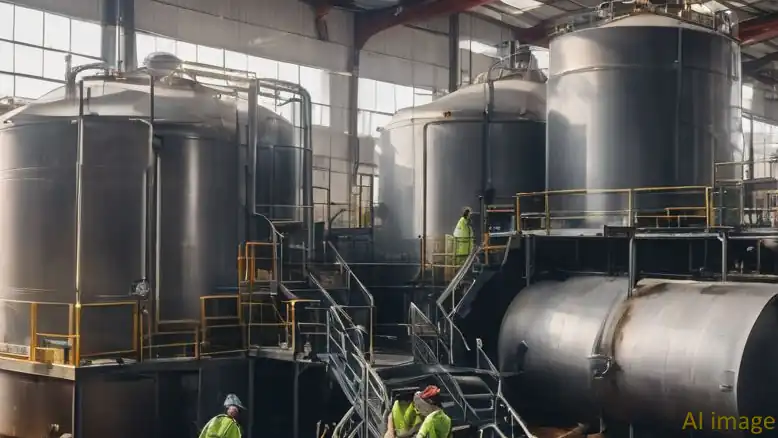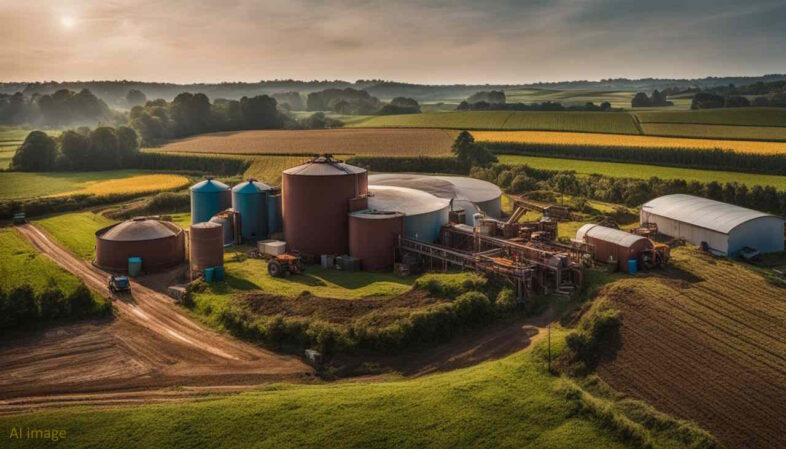In this article we are exploring biogas examples read on and learn how organic waste can fuel energy. Production
Biogas is a type of gas that comes from rotting stuff like leftover food and animal poo. People make it by letting these things break down without any air around. It's mostly made of two gases called methane and CO2.
Biogas can be used instead of other fuels that are not good for the Earth, such as coal or oil. This is because when we use biogas, we send less harmful stuff into the air which helps our planet.
There are a lot of good things about biogas! It makes fewer greenhouse gasses go up into the sky which keeps our world cooler. It's also something that will not run out because we always have more waste to turn into energy.
Plus, it helps us throw away less rubbish in landfills since we use it to make power instead.
With special machines called digesters, people can change biogas so it becomes even cleaner and then put it in pipes that go to houses or cars for us to use for cooking or driving! Some very clever folks are making smart machines that help us get this energy from trash better than before.
All over the world, different places do this in different ways – some countries have laws saying they must do it while others are just starting out. In places where there isn't much money or other types of fuel, using scraps to create biogas really helps people live better lives with more power!
Now hold on tight – let's look deeper at how this amazing gas turns yesterday's apple cores and cow pats into tomorrow’s bright lights and warm homes!
Biogas Examples – Key Takeaways
- Biogas is a type of energy that comes from breaking down organic waste like food scraps and animal poop without air. This process creates methane, which we can burn for heat and power.
- People are using smart biogas digesters to make gas from rubbish. These systems use computers and sensors to work better and give us more energy.
- Different countries have their own ways of working with biogas. Some mix it into their gas networks, while others just use it for electricity or as fuel for vehicles.
- In places with less money, biogas helps people make their own power without hurting the earth. It uses farm, animal, and kitchen waste to create light and heat in homes.
- New laws are helping biogas become more popular by making sure there's support for green energy projects. This means cleaner air and less rubbish going to landfills.
What is Biogas?
Let's dive into the world of biogas and later we provide our biogas examples, shall we? Picture this: a silent powerhouse, churning away as it transforms your everyday kitchen scraps and agricultural leftovers into something quite extraordinary—energy! That's right; biogas is that friend you didn't know you had, turning waste into watts in the most eco-friendly rave there ever was.
No more spoiling the party for our planet with harmful emissions; biogas plants are like nightclubs for bacteria where the only thing getting trashed is.. well, trash. So grab your metaphorical hard hat – it's about time we took a peek behind the scenes at nature's own circular economy in action.
Biogas Definition
Biogas is like a treasure hidden in the stuff we throw away. Think of it as gas made from old food and animal poop. Special tiny creatures eat up this waste when there's no air around, a process called anaerobic digestion.
They turn it into biogas which has lots of methane, CO2, and some other gases mixed in.
Imagine taking your leftovers, grass cuttings, or farm animal droppings and instead of them just piling up or rotting away, these things get put to good use! The magic happens inside a digester – kind of like a giant stomach – where all that organic matter gets broken down without any oxygen.
That's how you get biogas; it’s pretty smart recycling if you think about it!
This isn't just any kind of gas though; biogas is special because we can keep making more as long as there’s waste around. It's clean energy that doesn't add new bad stuff to the air like burning coal or oil does.
Plus, turning waste into energy means less trash ending up in landfills – talk about hitting two birds with one stone!
Production methods
- Organic materials gather in a digester. Think of a big, closed-off tank where no oxygen hangs out.
- Microbes get busy inside. They munch on the stuff like food scraps and plant material—no air needed.
- Anaerobic digestion kicks off. That's science – talk for “breaking down with no oxygen.” This step is key because it makes methane, which is the main part of biogas.
- Time plays its part. The mix has to sit and ferment. It's like making bread but with organic leftovers, not flour.
- Heat helps things along. Turning up the temperature gets those microbes working faster.
- Biogas starts to bubble up. As the tiny life does its thing, gas forms and rises to the top.
- Capture that gas! It's pulled from the digester and stored for later.
Composition
So, you're curious about what's in biogas? Picture this: a bunch of tiny bacteria munching on organic waste like food scraps or animal manure. As they break it all down, these microscopic creatures create a gas mainly made up of methane and carbon dioxide.
Sure, there are other gases in the mix too but think of methane as the star player here—it's the one that really packs a punch for creating energy.
Now, methane (CH4) is pretty amazing because when you burn it, you get heat and power. And let's not forget carbon dioxide (CO2), which kind of acts like a sidekick by helping out during the whole process.
This duo isn't just floating around—they come from something called anaerobic digestion. It's basically where all this magic happens without any oxygen getting involved at all! Simple yet brilliant; our unseen bacterial friends are doing their bit to turn waste into valuable fuel.
Benefits of Biogas
The often-underestimated hero in the renewable energy lineup, biogas flexes its muscles by turning the headache of organic waste into an energy powerhouse. It's a win-win for both our planet and our persistent pursuit of sustainability; transforming scraps and sludge into something that keeps the lights on – quite literally.
Reduced greenhouse gas emissions
Making energy from organic waste through biogas is a big win for the planet. Why? Well, one main reason is it cuts down on greenhouse gases that heat up our world too much. Use biogas, and you're saying ‘no thanks' to letting nasty gases like methane escape into the air.
Methane's not friendly – it traps heat way better than carbon dioxide.
Imagine all that rotting food or farm waste. If left alone, it would just pump out methane as it breaks down. But with biogas tech, we capture that gas and turn it into power! It's like magic – but real – taking something smelly and making something useful without harming the air we breathe.
Organic waste doesn't have to be a problem when we can transform it into clean energy using smart green technology. This clever move reduces our carbon footprint by swapping fossil fuels for this renewable energy source.
Plus, sustainable agriculture gets a helping hand as well because farmers can use leftovers to make their operations greener. Now isn't that good news? For everyone working towards environmental protection, creating biogas stands out as an amazing climate change fighter!
Renewable energy source
Biogas stands out as a shining star among renewable energy sources. It's like nature's own power plant, turning leftovers and waste into energy. Imagine the banana peels from lunch or cow manure from farms getting a second life to light homes and cook food! Farms, businesses, and even cities can use this powerful gas without leaning on old-school fuels like coal.
With biogas, we tap into something special – it never runs out as long as there’s organic stuff to feed it. This isn't just good news for us; it's brilliant for our planet too.
It slashes the nasty gases that heat up the earth and helps us tackle the rubbish problem in one go.
Harnessing biogas means smarter living with sustainable power at our fingertips. From small villages to big industries, everyone gets a piece of this clean-energy pie. It’s reliable power that keeps things buzzing day or night without hurting Mother Earth – now that's pretty awesome!
Organic waste management
Organic waste management turns leftovers, such as food and plant material, into something useful. Instead of letting this waste rot in bins or pile up in landfills, we can make it work for us.
We use a process called anaerobic digestion to break it down without oxygen. This method lets tiny bugs eat the organic matter and create biogas—a mix of mainly methane gas. Think about how awesome that is; our everyday scraps get a second life as clean energy.
This great trick cuts down on nasty smells and greenhouse gases from old garbage dumps. Plus, managing waste like this means less trash heading to those overflowing landfills—it's an all-around win! Moving forward into processes and applications of biogas shows just how far we've come with this green energy solution.
Processes and Applications of Biogas
In the realm of biogas, it's a whole universe where waste isn't just tossed aside—no, no—it's transformed into a veritable goldmine of energy, driving cars, warming homes and even getting piped straight into the gas grid; isn't that something worth delving deeper into?

Biogas examples – upgrading
Biogas upgrading transforms raw biogas into biomethane. This purer form of gas can power homes, fuel cars, or be added to the gas grid.
- Removing impurities is the first step in upgrading biogas. It involves taking out things like water vapour, hydrogen sulphide, and carbon dioxide.
- Boosting methane content is crucial. Biogas usually contains 50-70% methane but after upgrading, methane can increase to up to 98%.
- Several methods exist for biogas upgrading. These include water scrubbing, pressure swing adsorption, and membrane separation.
- Water scrubbing pushes biogas through water where carbon dioxide and other gases dissolve, leaving mostly methane behind.
- Pressure swing adsorption cycles the gas through materials that hold onto impurities under pressure but release them when pressure drops.
- Membrane separation uses special filters that let only small molecules like methane pass through while blocking others.
- Upgraded biogas becomes renewable natural gas (RNG). This means it's made from organic material and can replace fossil fuels without adding more greenhouse gases.
- RNG is versatile; it can fuel trucks as liquefied natural gas (LNG) or compressed natural gas (CNG), or go to homes for cooking and heating.
- Gas purification technology has come a long way. Now we have smart systems that adjust processes automatically for the best quality biomethane.
- Energy generation gets cleaner with upgraded biogas. It burns much cleaner compared to raw biogas or traditional fossil fuels.
Biogas examples – gas-grid injection
After improving biogas quality, the next step is to inject it into the gas grid. This means putting cleaned-up biogas where it can go to homes and businesses just like regular natural gas. Here's how that works:
- Cleaning biogas turns it into Renewable Natural Gas (RNG), so it's good enough to mix with the regular gas supply.
- This clean RNG travels through pipes in the ground, reaching many places for different uses.
- Methane capture from waste stops this harmful gas from getting into the air while making energy we can use.
- Since RNG fits right in with other natural gases, there's no need to change existing pipes or systems.
- Energy production gets greener as more organic waste becomes useful fuel instead of just sitting around.
- Trucks and buses can run on RNG too, meaning they use cleaner fuel and make less pollution.
- Government rules help make sure more RNG gets used, helping the planet and cutting down on waste.
Biogas Examples – Biomethane in transport
Biogas is making waves as an alternative fuel for vehicles, when upgraded to become “biomethane”. It's a clean choice that can reduce harmful emissions from transport.
- Biogas turns organic waste into a useful form of energy for buses, cars, and even trucks.
- On the road, vehicles powered by biogas emit far fewer pollutants than those running on petrol or diesel.
- Converting fleets to biogas could significantly cut down the transportation sector's carbon footprint.
- Taxi services and public buses in many cities are now using biogas, showing it works well in real life.
- This environmentally friendly fuel comes from materials like food scraps and farm waste.
- Refueling stations for biogas are popping up, making it easier for drivers to go green.
- Tractors and farm equipment can also run on biogas, tying food production to sustainable practices.
- Creating biogas involves capturing methane from decomposition, which would otherwise harm our atmosphere.
- Smart technology helps turn waste collection into a source of renewable energy right where we live.
Biogas Examples – Heat and electricity generation
Transforming organic waste into energy is a clever trick. It not only deals with trash but also gives us heat and power.
- Organic waste breaks down in the absence of air. This process, called anaerobic digestion, produces biogas.
- Biogas mainly consists of methane. Methane is a powerful fuel that can generate lots of energy.
- Engines and microturbines turn biogas into electricity. They work just like regular generators but use biogas instead of petrol.
- Fuel cells may also use biogas for power. These are advanced systems that make electricity through a chemical reaction with the gas.
- Captured heat warms up buildings or processes. After making electricity, the leftover warmth from engines can heat water or buildings – nothing goes to waste!
- Some places inject upgraded biogas into gas grids. This means homes can get energy from organic waste without even knowing it!
- Electricity from biogas can go to the power network. That way, your lights or computer might run on energy made from yesterday's leftovers.
- People sell extra electricity back to the grid. If someone makes more power than they need, they can make money by giving it to others.
Technological Advancements in Biogas Production
In the realm of biogas, a wave of innovation has brought forth smart digesters and pint-sized powerhouses alike – it's not just about size, but also clever design. The industry is buzzing with technologies that tackle waste and energy woes hand-in-hand; think streamlined sanitation solutions or digesters that text you when they're full (how polite!).
These advancements are reshaping how we approach renewable energy from our leftovers, creating cleaner prospects for both people and planet.

Smart biogas digesters
Smart biogas digesters are changing how we think about turning waste into energy. These clever machines are biogas examples that take food scraps, plant matter and even animal waste and turn it all into useful gas.
This isn't just any gas though; it's a type that can power homes, cook meals and even run buses! You could say these smart systems give garbage a brand-new life.
They work by mixing organic waste with water in a big tank. Microbes in the mix eat up the waste, making biogas as they go. Engineers have made these digesters really smart now. They use sensors and computers to check everything is working just right, which means more biogas for us!
People all over the world are getting excited about these gadgets. Why? Because they make clean energy from stuff we normally throw away! Plus, cities can save money by using local waste instead of buying fuel from far away.
With tech like this, our future looks brighter—and cleaner too!
Small-scale biogas systems
Small-scale biogas systems are turning heads in the renewable energy scene. Imagine having your own mini power plant, right in your backyard! That's pretty much what's happening with these clever setups.
People everywhere are getting on board, and it's easy to see why. You chuck in stuff like leftover veggies or cow poo, and voila — you get energy.
These nifty little units don't just help make electricity; they're also champs at managing waste. Instead of throwing out those food scraps or dealing with smelly animal waste, these systems turn them into something useful.
The magic happens through anaerobic digestion – that’s when tiny bugs munch away on the waste without any air around – and then gas bubbles up ready to use! It’s a win-win situation for clean energy fans and folks who hate wasting things.
Biogas examples – sanitation
Moving from small-scale systems to large impacts, biogas has a key role in sanitation. It turns waste into something useful and helps keep our water clean. With biogas technology, we can take care of poop and other organic stuff nobody wants.
This means less pollution in rivers and seas.
Biogas plants do great things for community health too. They make sure human waste doesn't spread germs or bad smells around towns and villages. Plus, turning waste into energy means we rely less on oil and coal.
So, using biogas can help us live cleaner lives and look after the place we call home—planet Earth!
Global Developments in Biogas
As we cast our gaze across the globe, it's clear that biogas isn't just a flash in the pan; various nations are tuning into its potential, crafting policies and sparking initiatives that could well redefine renewable energy landscapes—so let's dive deeper and fuel our curiosity about biogas examples of these worldwide winds of change.
Biogas Examples – Legislation and policies
Laws and rules are big players in the game of biogas growth. They help kick-start projects and make sure biogas is a go-to for green energy. Think about it like this: without the push from governments, it would be tough to get the biogas party started.
It's all about giving that nudge towards sustainable development—kinda like telling kids veggies are good by making them into fun shapes.
Now, if we scoot over to Europe, they're setting some serious green goals with their regulations. They want cleaner air and less waste—so they're saying ‘thumbs up' to folks who choose biogas.
On the other side of the world, China has spotted biogas as a big player too. Their leaders are dropping new policies so more people can turn yucky waste into something super useful.
It's not just about being kinder to our planet; it's smart business too! Energy policy gurus know that building a strong set-up for biagases means jobs and cash can flow nicely. Plus, let’s face it—it feels pretty great powering your car or heating homes knowing you're doing good for Mother Earth! So yeah, while those legal bits might seem dull, they’re actually pretty much the secret sauce in making sure our future stays bright (and clean!).
Regional variations
Different countries have their own ways of making and using biogas. While some places focus on turning agricultural waste into energy, others might use organic household trash more.
In warmer areas, simple outdoor systems work well because the heat helps break down the waste faster. Colder regions might need indoor setups to keep the process going all year round.
Folks in Europe are big on mixing biogas into their gas networks; this means they clean it up so it's like natural gas and pump it through pipes for people to use in homes and businesses.
This isn't as common yet in other parts of the world where they may prefer using biogas examples like these just to make electricity or fuel for cars and buses. Each place has its special tricks based on what works best there!
Impact on developing countries
Shifting focus from regional variations, it's clear these biogas examples have a big role in changing how energy works in poorer parts of the world. Countries that don't have lots of money can use biogas to cut down on burning coal and oil.
This move helps them rely more on what they can renew themselves. These biogas examples can turn waste from farms, animals, and kitchens into power for lights and cooking.
Biogas opens doors for folks in these places to get better at making their own energy. It means they are not as stuck if there is no fuel from other countries available or if prices jump up too high.
Clean energy initiatives like these make life healthier and protect nature—two wins at once! More people having electricity without harming our planet is the aim, and biogas is showing it's possible even where dollars are short.

Biogas Examples a Conclusion
So, we've seen, in these biogas examples, how our leftover food and farm waste can actually power up our homes and cars. Biogas turns this rubbish into a treasure of clean energy. It's amazing because it cuts down on nasty stuff in the air and gives us endless power from things we don't want anymore.
We're getting smarter at making biogas with cool new gadgets that fit even in small spaces. All over the world, different places are catching on to how great biogas is for people and the planet.
Remember this: every time you toss banana peels into your bin – it could be lighting someone's home tomorrow!
Biogas Examples FAQs
1. What is biogas made from?
Biogas comes from rotting plants, food scraps, and animal waste—stuff we usually just throw away!
2. Can biogas really power things like my house?
Absolutely – your home can light up and stay warm using energy from biogas.
3. Is making biogas good for our planet?
Yep, using these biogas examples it's a thumbs-up for the Earth—it cuts down on rubbish and makes clean energy!
4. How long has this whole biogas thing been around?
Believe it or not, people have been getting in on the biogas action since way back in the 1800s.
5. Could I make my own mini-biogas plant at home?
Sure thing! With a bit of know-how, you can set up a small-scale digester to turn your leftovers into power.
InstaDoodle Review – A Low Cost Whiteboard Sketch Video Software for Info and Promo Videos
Looking for affordable whiteboard animation software? InstaDoodle – Whiteboard Sketch Video Software helps create engaging explainer and promo videos with ease. Try it now
Understanding Landfill Gas: Hazards and Solutions
Landfill gas is an inevitable byproduct of waste decomposition. As waste breaks down, it releases gases under pressure, seeking an escape. Without proper systems, these gases can travel in unpredictable ways. Let's consider what landfill gas is, the potential risks it poses, and how we can effectively manage it. What is Landfill Gas? Landfill gas […]
What is SAF Made Of? An Introduction to Sustainable Aviation Fuel
Discover what is saf made of as we explore sustainable aviation fuel composition, including organic waste, crop residues, and other renewable sources powering eco-friendly flights
What is the Best Clean Energy Source for the Environment?
Explore the best clean energy alternatives that are good for the environment. Learn about the latest developments in renewable power technology.






